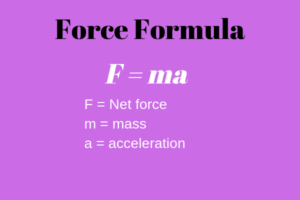The formula for force states that the force is equal to mass that is multiplied by the acceleration. So, if we know the mass and the acceleration, we just have to multiply them together and then we will get the force. Let us learn the force formula here.
Definition
Force is basically an interaction between the objects because of which they make changes in their motion. The force is measured in Newtons (N). Newton is the scientific unit and we use it for measuring weight. 1 Newton is equal to around 0.22 pounds. So, a girl that weighs only 100 lbs. would be equal to about 445 newtons, or her force due to the gravity (Fg).

Newton’s First Law
The First Law of Motion by Newton says that every object persists to be in uniform motion in a straight line or in the state of rest unless an external force acts on it.
Newton’s Second Law
The second law of motion by Newton says that the force is equal to the change in momentum per change in the time. For a constant mass, force equals the mass times acceleration, i.e. F = m x a.
A vector equation is the modern statement of newton’s second law:
\( \vec{F}\) = \(\frac{\vec{dp}}{dt}\)
Where:
\(\vec{p}\) = momentum and \(\\vec{p}\) = mv
If the time interval for the applied force increases, as a result, the value of the force applied decreases.
From newton’s second law of motion:
\(\vec{F}\) ∝ \(\frac{\vec{dp}}{dt}\)
\({\vec{F}}\) = K × \(\frac{{\vec{dp}}}{dt}\) = \({\vec{kma}}\)
For simplicity, the constant of proportionality (k) is decided to be 1, therefore:
\(\vec{F} = \vec{ma}\)
Newton’s Third Law
Every time a body exerts a force on another body, the latter simultaneously exerts an equal and opposite force on the first one. In vector form, if \(F_{1,2}\) is the force of the body 1 on the body 2 and F_{2,1} \(F_{2,1}\) that of that of body 2 on body 1, then:
\(F_{1,2} = -F_{2,1}\)
In a system composed of object 1 and object 2, the net force on the system due to their mutual interactions is 0:
\(F_{1,2}\) + \(F_{2,1}\) = 0
Solved Examples on Force Formula
Example 1. A constant force acting on a body of mass 3.0 kg changes its speed from 2.0 m/s to 3.5m/s in 25 s. The direction of the motion of the body does not changes. What is the magnitude and what is the direction of the force?
Solution
Mass of the body, m = 3 kg
Initial speed of body, u = 2 m/s
Final speed of body, v = 3.5 m/s
Time, t = 25 s
Using the first equation of motion, the acceleration (a) produced in the body can be calculated as:
v = u+at
a = \(\\frac{v-u}{t}\)
= (3.5−2)/25 = 0.06m/s2
F = ma
= 3 × 0.06 = 0.18 N
Since the application of the force does not change the direction of the body, the net force acting on the body goes in the direction of its motion.
Example 2. A stream of water flowing horizontally with a speed \(15ms^{-1}\) of gushes out of a tube of cross-sectional area \(10^{_{-2}}m^{^{2}}\), and hits a vertical wall nearby. What is the force exerts on the wall by the water’s impact, assuming it does not rebound?
Solution
Speed of water stream, v = 15 m/s
The cross-sectional area of the tube, A = 10 m
The volume of water that comes out through the pipe per second,
V = A x v = 15 x 10 m /s
Density of water, = 10 kg/m
Mass of water that flows out in the pipe per second = density V = 150 kg/s
The water hits the wall and doesn’t rebound. Therefore, the force that the water exerts on the wall is given by
Newton’s second law of motion as:
F = Rate of change of momentum = P / t.
= mv / t
= 150 x 15 = 2250 N






Typo Error>
Speed of Light, C = 299,792,458 m/s in vacuum
So U s/b C = 3 x 10^8 m/s
Not that C = 3 x 108 m/s
to imply C = 324 m/s
A bullet is faster than 324m/s
I have realy intrested to to this topic
m=f/a correct this
Interesting studies
It is already correct f= ma by second newton formula…